 | 330 GT Registry |  |
Sicily's lost TREASURES
HISTORICAL, RELIGIOUS, BEAUTIFUL AND MYSTERIOUS, SICILY IS AN
ISLAND OF REMARKABLE DIVERSITY. WHAT BETTER WAY TO GO ON
THE TRAIL OF THE REAL SICILY - WITH IT'S STUNNING BUILDINGS
AND ARCHAEOLOGICAL ARTEFACTS - THAN FROM BEHIND THE
WHEEL OF A FERRARI? THE ROADS ARE GOOD TOO...
WORDS: PHILIPPE DAVERIO
PHOTOGRAPHY: GABRIELLA NORIS
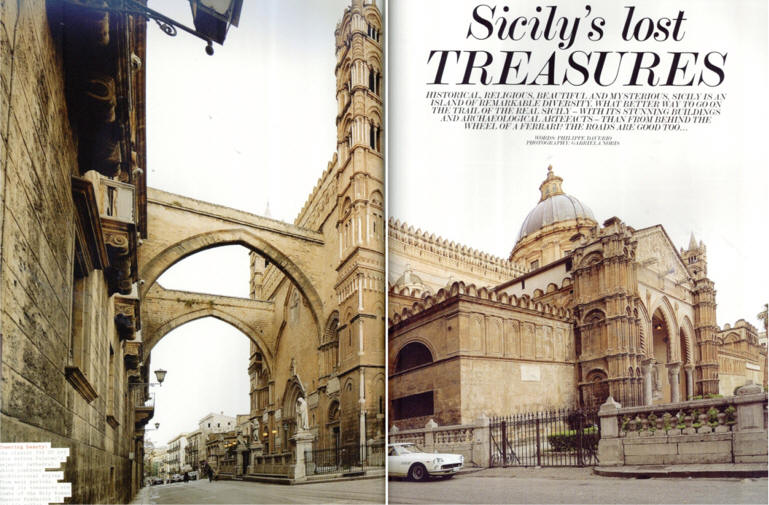
Towering beauty: the classic 330 GT 2+2
fits before Palermo's majestic cathedral,
which combines architectural styles from many periods.
Among its treasures are tomb of the Holy Roman Emperor
Frederick II, and his mother, Constance of Sicily.
ARCHAEOLOGY & ART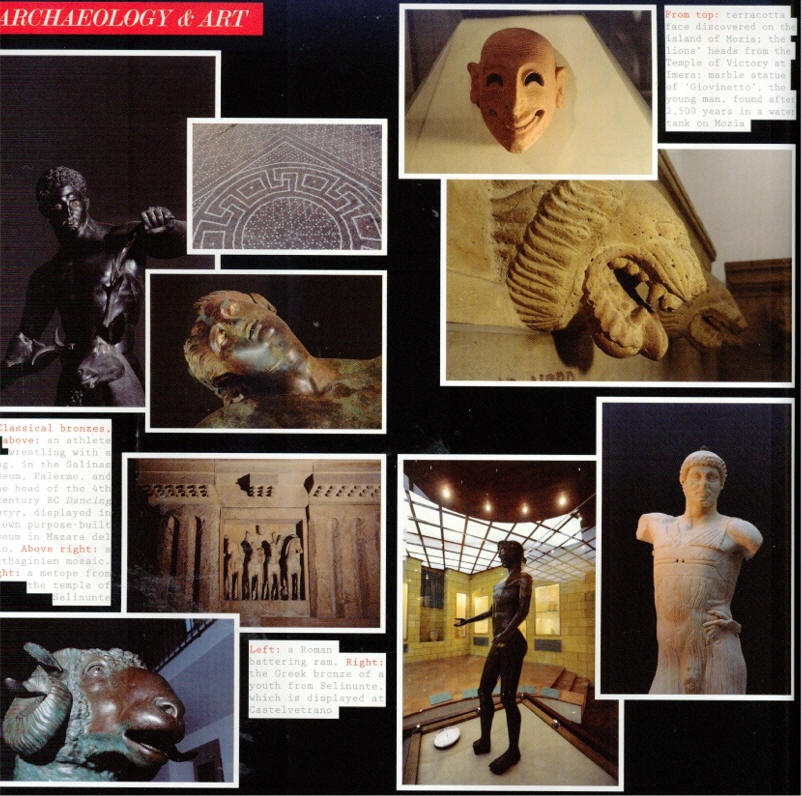
Classical bronzes, Above: an athlete wrestling with a stag in the Salinas Museum. Palermo, and the head of the 4th century BC Dancing Satyr, displayed in its own purpose-built museum in Mazara del Vallo. Above right: a Carthaginian mosaic. Right: a metope from the temple of Selinunte. |
| Left: a Roman battering ram. Right: the Green bronze of a youth from Selinunte, which is displayed at Castelvetrano. | . | From Top: terracotta face discovered on this island of Mozia; the lions' heads from the Temple of Victory at Imera; marble status of 'Giovinetto', the young man, found after 2,500 years in a water tank on Mozia |
SICILY IS one of the most unexpected lands. It is called splendid, and splendid it appears if the eye rises above the building that in the second half of the 20th century spread in every direction in an attempt to cancel out the glories of a colourful past. Fortunately it stills finds redemption through the landscape that is so fierce, strong and immense as to overcome any human attempt to wipe it out. And fortunately the climate, land, sea, sun, rock and wind are extollers that constantly leave the island with the grit that characterises its history.
In reality Sicily must be tackled like a club sandwich. Not those served up in respectable hotels that present this very basic of foods cut into four pieces and elegantly arranged on a china plate, but like the one that Walt Disney gets Donald Duck to eat, piled high, consisting in its cartoon-like way of 10 layers on top of each other and smothered in a coloured sauce seeping through it all. The knife sinking into a heap of this sort allows the different remains that make up the complex structure to tower again; it is up to the palate to distinguish them.
A similar thing happens to the traveller crossing Sicily. He finds himself necessarily having to taste a mixture of flavours linked by a single sauce. But if he has a sufficiently well-trained palate he will find it easier to distinguish the myriad levels all that exist. They start from a base that could be called native and which now has all but disappeared, apparent only in the coastal climate that is the same today as it ever was. The climate inland has undergone constant modification that the most ancient deforestation activity in Europe inflicted on it, since the island was one big unrest until some 2,700 years ago.
.It was the Greeks who set about changing Sicily’s features. For the ancient Greeks who emigrated en masse during the years of the Doric conquest, like so many ants driven out of their age-old homes, the discovery of lands to the west — those which took the Latin name of Magna Graecia — could be compared to the discovery of New World that America represented to the Europeans in the 16th century, the Everything there was bigger, better and more fertile. The Greeks had never before laid eyes on such extensive tracts of agricultural land where all that had to be done was to cut down the trees to plant the grain.
And the Greek wanderer put down permanent roots in these parts, as he did in Calabria creating his Utopias, from Polyphemus, the one-eyed monster of Ulyssean legend, to Pythagoras, the man of a thousand calculations who was terrified by _ the idea of eating broad beans; Empédocles, the philosopher from Agrigento; and Archimedes, the Syracusan man of science.
Carthage was attracted by a similar fortune and took control of the island — Carthage and its Phoenician friends and relations. Rome in turn saw rich pickings; it destroyed Carthage and incorporated the island into its possessions. Clear signs of all this can still be found in a landscape that lives with this fearful yet fascinating history. The Phoenician traces are found in the museums of Palermo and on that miracle of environmental beauty, the isle of Mozia, saved thanks to the archaeological passion of an English family, the Whitakers, who had come here to make wine in the 19th century. In unmistakable terms, Mozia documents the tradition that saw the relics of the Carthaginian era charged with ancient magic, and the presence of a Greece ‘away from home’ that allowed the mixing of tastes and flavours that were prohibited in Attica while in the new land were combined with local standards of prudery. Hence the ambiguous fascination of the marble ephebus housed-in the museum, attractive and erotic like a classical nude, but dressed in Sicilian style. The garment only highlights his attributes because it appears to comprise a lightweight, diaphanous veil, expertly realised by its highly skilled sculptor.
The city of Marsala keeps watch opposite, recently returned to its belle époque beauty by high-grade restoration. And the city is highly charged with ‘recent’ evocations, It is here that the friends of Lord Nelson discovered the wine that could save England from the lack of Portuguese wine, which was subject to the continental blockade imposed by Napoleon. At that time London ran the risk of having to drink tea alone. Having irremediably lost the trade with the historic wine from Bordeaux, which had been shipped down the Thames since the days of the Plantagenets, it was saved by the sunny discovery of Sicilian wines.
Imposing sailing vessels loaded with barrels left Marsala. It was here that the spirit to beat the French Jacobins was rekindled. It is said that the ships also brought to London the shirts of the Sicilian aristocracy who loved the way the ironing women of Her Britannic Majesty starched them before passing a hot iron over them. But the ships came back filled with iron railings for the balconies of Palermo as the shirts were not heavy enough to act as ballast.
All the recent stories — those from the past 1,300 years — stem from the legendary capital Palermo. In 734 BC, the Phoenicians from the city of Tyre in Lebanon established a merchant economy in Palermo. In the ninth century AD, it came under Arab governance. Around a century later it was replaced by the tireless Norman adventurers of the house of Hauteville who, being very determined and not very numerous, allowed their progeny to live alongside the Arab population for many years, as documented by some of the most magnificent buildings imaginable — and among the casualties of recent property speculation.
RELIGION & SUPERSTITION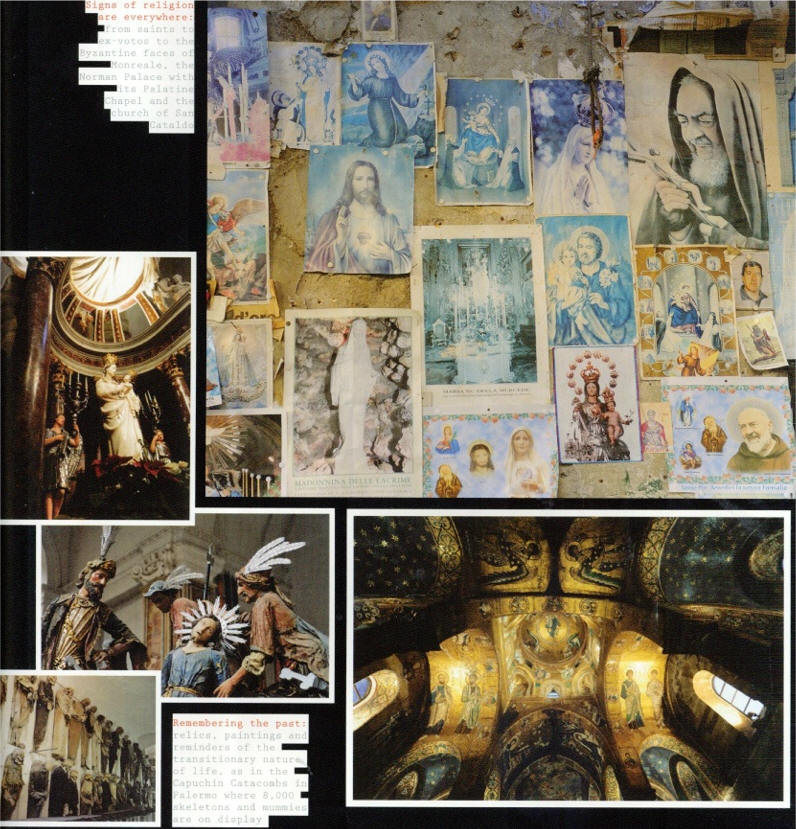
Signs of religion are everywhere: from saints to ex-votos to the Byzantine faces of Monreale, the Norman Palace with its Palatine Chapel and the church of San Cadaldo. | Remembering the past: relics, paintings and reminders of the transitionary nature of life, as in Capuchin Catacombs in Palermo where 8,000 skeletons and mummies are on display. |
Today, the various chapels remain the same in their majestic ruins, as does the so-called Norman palace that is now the seat of the regional government. But some of the most moving churches and the exemplary Zisa mansion also bear witness to those very potent years. The latter houses a small document that sums up the entire history of the 12th century. It is a small tomb stone that a Latin priest had engraved in 1148 in memory of his mother Anna. A small gesture of filial piety that over the years has become the greatest of documents: the writing that adorns the stone around a sober octagonal design is the translation of the same text into the four languages that were then spoken in what was the most cosmopolitan city of the Mediterranean basin — Latin, Greek, Arabic and Hebrew. The only language missing was Italian, then in its infancy, that produced the first examples of poetry in the sophisticated court of Frederick II of Swabia.
PLACES OF INTEREST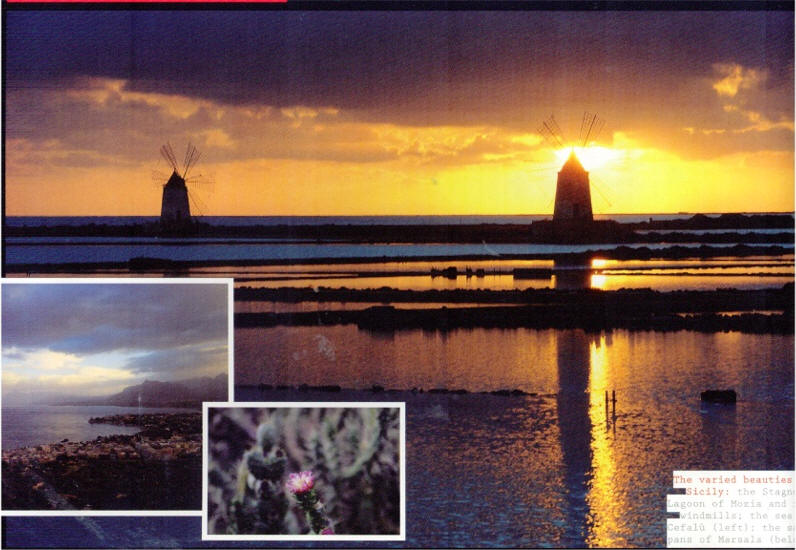
The varied beauties of Sicily: the Stagone Lagoon of Mozia and its windmills; the sea at Cefalù
(left); the salt pans of Marsala (below)
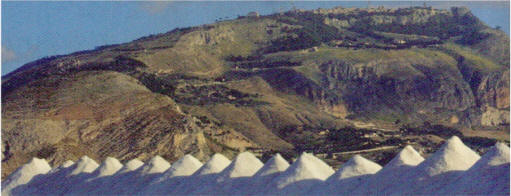 | |
| The many result of Sicily's transitions was the accumulation of the most precious treasure, an inclination to courtesy | 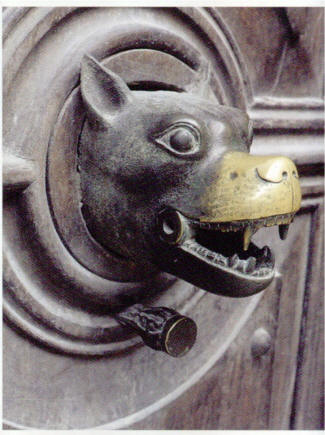 |
Frederick had grown up in the streets of the city, he loved Palermo and, as in the best of loves, he betrayed it by moving the capital to Naples where he founded the first university in the Mediterranean area. Sicily had gone from Norman to Swabian but, in the absence of heirs, it passed into French hands under the Angevin dynasty which also controlled Naples, until the Sicilian Vespers rebellion in 1282.
Spain was able to get its hands on all of this. It was the European dream of Emperor Charles V to create an infinite Spain which, at the time, had no cities of note. Its had Antwerp, Milan, Genoa and Naples, and later Palermo. Palermo learned the new tenets of town planning that were being tried out in Genoa; the lay congregation architecture being invented in Milan; and the taste for magnificence that the court of Spain considered a natural prerogative of public life. The city became splendid. today it still has the buildings and the memories.
And perhaps the memories are worth more than the buildings themselves. Because in the transition from Greekness to Hellenism, from Hellenism to the soft Romanness of Cicero on holiday and then to the infinite complexity of the Byzantine world; from the splendid court of the Normans to the poetic and unsettling court of Frederick II; from the international gothic reinterpreted by the Aragons to the common baroque of Spain — the city accumulated the most precious of treasures, a natural inclination to courtesy, as courtesy is the highest art of court life.
And it is this courtesy that is found when the ice-cream maker from Monreale — right next to the more Roman than Romanesque cathedral in a city that is more Arab than Christian — dedicates a large swathe of his time to composing the most baroque of ices in the colours, flavour and shape requested by a passing tourist who might never come back. This courtesy is found again in the chaotic traffic of the city when the motorist is not given the right of way at a crossroads on the basis of a little thing like the colour of a traffic light, but instead after an exchange of glances in which one of the two motorists gives way. Just like in the epic years gone by when the warrior’s sword hung from his left hip, and the years when nobility was everything.
IF THERE is any doubt that the magic of a place comes from its history, then arriving in Sicily dispels such uncertainty. There are few places in the world where the melding of cultures and civilisations has created such a magnificent array of stimuli for the visitor. Added to this is the beauty of the locations, from the most famous spots to the unspoiled gems, as well as the quality of the local flavours and aromas.
FERRARI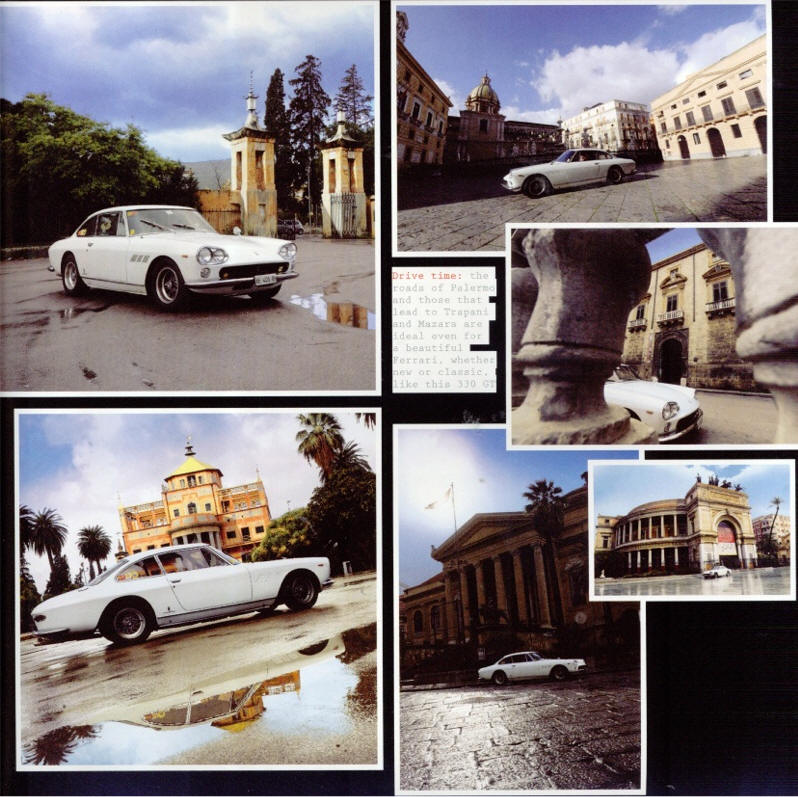
Drive Time: the roads of Palermo and those that lead to Trapani and Mazara
are ideal even for a beautiful Ferrari, whether new or classic, like this 330 GT.
SICILY: A VOYAGE THROUGH AROMAS AND FLAVOURS
There’s also something reassuring about driving on the island: if you are able to — and I urge you to — take your Ferrari to Sicily, you will find roads that are safe and, above all, fast (it is full of motorways and other similar roads). However, it’s more difficult to venture into the tiny streets of the old towns that are characteristic of the islands (and for this you'd be better off with a Fiat 500). The tradition in Sicily is for even the peasants to live in large towns or cities, going back and forth to the land they cultivate, and this has led to the growth of populous and fascinating towns with streets that are narrow and often impassable by car.
To get to Palermo by car you can take the boat from Genoa, Livorno, Civitavecchia or Naples. Leaving from Maranello, an almost obligatory stop for all Ferraristi, the first two departure points are recommended. It’s a pleasure to say that, for the visitor, Sicily is a thousand miles away from the stories of criminality and is no different from any other well-known European destination. Ferrari had proof of this with the international press presentation of the new California, between Mazara del Vallo and Trapani, which showed the journalists just how liveable this land is.
Sicily is truly a sensory playground. The short trip in a little boat (one that created a lot of noise given its slow progress) that navigates from the salt pans of Mazara to the Phoenician island of Mozia (return ticket: €5), ploughing through the tranquil waters of the Stagnone Lagoon, is sheer poetry. The old windmills, now used for pumping water, nestle between the mounds of salt. It’s a Dutch painting, but one with Sicilian colours.
The island is a fairly recent discovery of the English Whitaker family who arrived in the 19th century and contributed, along with the Florio, Woodhouse and other families, to making Marsala such a very British drink (don’t miss the Florio cellars, in Marsala itself). Walking silently through the remains of the ancient city is an enchanting experience, reinforced by the sight of the statue of the young Greek boy known as the Ephebe of Mozia.
FOOD & DRINK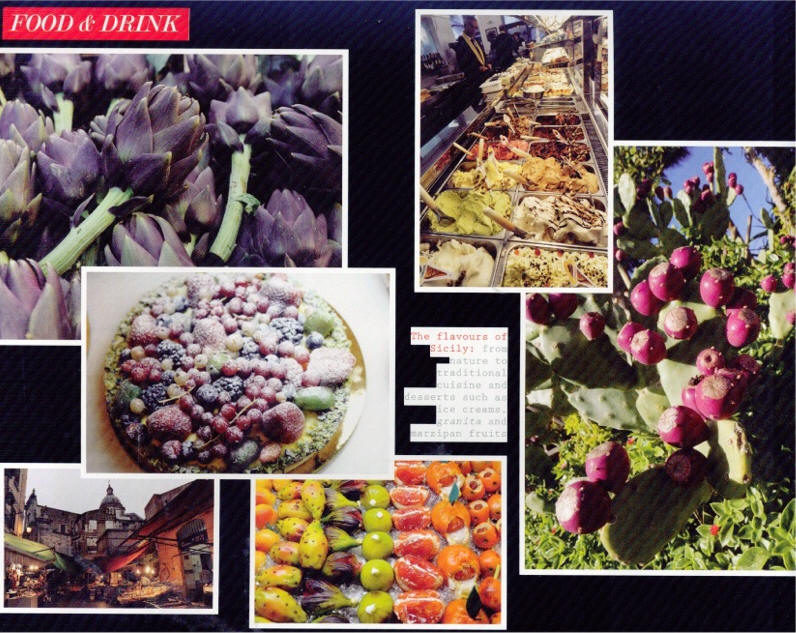
The flavours of Sicily: from nature to traditional cuisine and desserts such as ce creams, granita and marzipan fruits.
The elegant Kempinski Hotel (Giardino di Costanza) is the perfect place to stay in Mazara. The town is also home to a restaurant that rivals, in the intensity of the emotions it conjures, the famous satyr statue fished out of the sea by the crew of the Capitan Ciccio 10 years ago. Called Marmoreo, the restaurant is located on the port and, for a very practical reason, it is only open in the evening: by day it is a fishmongers. Towards evening, when the day’s sales are Over, tables are brought in and a basic menu is prepared based on the best of the day’s catch. It starts with raw fish, shellfish and oysters, followed by traditional soups then grilled fish — for €60 all in. Unmissable.
For those who like to satisfy both the palate and the brain, take the trip to the city of Selinunte, an ancient Greek archaeological site with ruined temples that stand the seashore looking towards the enemy, Carthage. Here, make a stop at Pino Cuttaia’s restaurant, La Madia, in Licata, This multi-Michelin-star restaurant offers a sophisticated modern reinterpretation of the flavours of Sicily (expect to pay around €60—€80, depending on the menu). Bravo!
Don’t miss Erice. Ascending the same road where the historic Erice hill-climb race is held, you get a 360-degree view of land and sea. According to legend, the town was founded by fleeing Trojans, became Carthaginian and later Roman, and was also the site of the temple of Venus Erycina. It is full of small bars and restaurants and charming small hotels, as well as myriad churches built, as everywhere in Sicily, on top of each other, just like the old castle.
Before arriving back in Palermo, a stop at the enchanting remains of the city of Segesta is recommended. Segesta, too, is an example of the Trojan landing in Sicily and the Greek presence, with its almost-intact Doric temple and the extraordinary Norman structure of Monreale, with its vast mosaics. Finally, head into Palermo itself, for a trip to the Palazzo dei Normanni (Palace of the Normans), Cappella Palatina (Palatine Chapel), Zisa (a summer residence of the Norman kings), Cathedral and, above all, for the flavours and smells, the secret bars and restaurants, and the markets. Worth exploring is the antiques market, very near the Cathedral, which is at its best in the morning. Then there are the markets of Ballard and Vucciria, where the stalls vie with the tiny shops nearby, selling spices, fruit and vegetables, meat and fish. any doubt that the Pick up cheese, vegetables in oil, candied fruit, and orange and mandarin honey.
Eating out depends on how adventurous you feel. At the legendary Antica Focacceria San Francesco, a favourite with actors and journalists since 1834, the speciality is spleen sandwich. If you’re not feeling brave enough to try that, there is also every other kind of traditional Sicilian food. Local wine is rapidly improving its international reputation and the Sicilians are rightly proud of it. There are many sophisticated wine bars, such as Mi Manda Picone in Via Paternostro, Martin’s, right next-door in Via Calascibetta, and Maestro del Brodo, which is only open for lunch. To these small and typical places you can add the many excellent restaurants wisely chosen by the guidebooks. The same applies to Palermo’s hotels; try the famous Villa Igiea.
And, something beautiful to finish your Sicilian jaunt — desserts. It would be a crime against Palermo to recommend just one pasticceria; all of them are excellent, with their ice creams and granita (water ices), almond-paste fruits, Sicilian cassata and rum baba, I’ll say no more because there are some things you simply can’t explain; better just to go to Sicily and try for yourself. FM
Copyright Ferrari SPA, 2009
